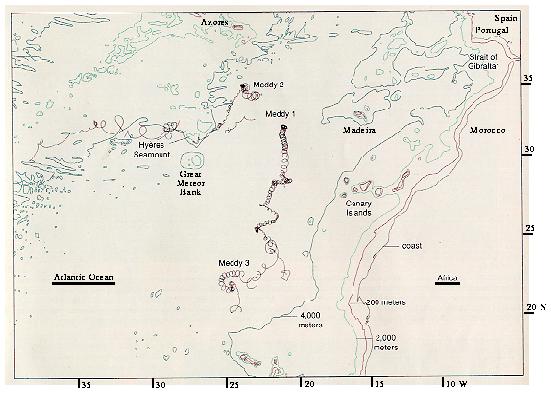Origin of Meddies


Three Meddies have been tracked for extended periods of time by listening to
acoustic floats from ships. Meddy 1 translated mostly southward and four
separate voyages tracked it for 821 days, to near-total decay off the coast
of Africa. Meddy 2, followed for 8.5 months, translated more to the west and
met a catastrophic end against Hyères Seamount, where it must have
released its contents of Mediterranean water, with its salt and heat
(and polution). Meddy 3 was tracked for 552 days.
These examples show that Meddies can play an important role in the transport
of water properties in the Atlantic ocean.
Lines in the figure represent the coast lines, and contours of depths of 200, 2000 and 4000 meters. Various seamounts and island groups are indicated.A lifetime of four to seven years can be inferred by backtracking Meddies to their likely origin near Cape St. Vincent, Portugal, at least for the Meddies that do not hit seamounts. All three Meddies had swirl speeds of around 30 cm/s, a rotation period of about 5 days, and a south to southwest velocity of 1--2 cm/s.
The ocean water at 1000 m depth, where the Meddies drift, does not move very fast, but the upper part of the Meddies lies within the generally soutwest-ward flow of the subtropical gyre, which could explain the direction of there travel. Furthermore, the latitudinal variation of the Coriolis force (the so-called beta-effect) causes an anti-cyclonic vortex like a Meddy to move to the southwest (on the Northern hemisphere).
To the west of Hyères Seamount tracks of other anticyclones can be seen. These could be weaker forms of Meddies, but then formed south of the Azores from meanders in the salty Mediterranean tongue. They appear to be as numerous as Meddies and they translate a little faster.
<=== Post-doc. research in Dundee page
 Jos van Geffen --
Home |
Site Map |
Contact Me
Jos van Geffen --
Home |
Site Map |
Contact Me